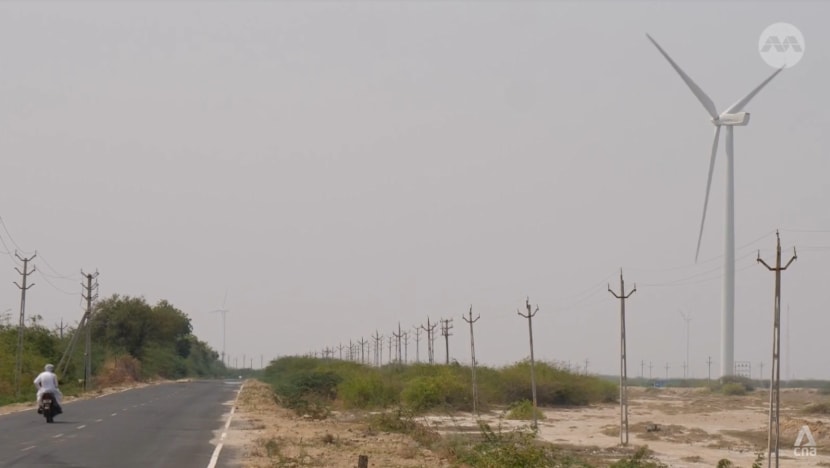India aims to be global superpower of renewable energy, but faces funding shortage
Demand for power is surging in the world’s most populous country, which has more than doubled its green energy capacity from a decade ago.

Windmills in India that generate renewable energy.

This audio is generated by an AI tool.
MODHERA, India: Those living in India’s first solar-powered village rely on the sun for almost all their electricity, with rooftop panels and a solar plant providing round-the-clock power to 6,500 residents.
The electricity is provided free of charge under a joint project between the central and state governments. While some problems have cropped up, such as lights being damaged by the new system possibly due to voltage issues, residents told CNA that solar power has improved their quality of life.
“Before, there was a shortage of electricity. It's very hot in the summer and people couldn't even use fans,” said resident Bipin Patel.
“Now, electricity is available for free 24/7, and people can use their fans and enjoy cold water from the fridge.”
Modhera, located in the western state of Gujarat, was chosen to be the country’s first solar-powered village partly because it houses a famous Hindu sun temple that dates to the 11th century.
The village’s solar project is part of the Indian government’s plans to generate half of its electricity from renewable sources by 2030.
Prime Minister Narendra Modi has also pledged for India to cut its emissions to “net zero” by 2070.
Mr Modi is currently seeking a rare third term in power, with one of his election campaign promises being to work towards the world’s most populous country becoming “energy independent” in the next few decades.
With costly fossil fuel imports expanding the country's trade deficit, developing renewable energy has become even more important for India.
However, while large strides have been made in scaling up energy generation from renewable sources, analysts said a lack of investment is slowing progress down.
LESS THAN HALFWAY TO 2030 TARGET
According to official figures, India has more than doubled its green energy capacity to 188 gigawatts from just over 80 a decade ago, when Mr Modi first came to power.
Despite this, however, the country is not even halfway to its target of 500 gigawatts by 2030.
Analysts said the goal is achievable, but factors including the cost of capital need to be addressed to make the sector more attractive to investors.
A report by think tank Ember estimated that India requires almost US$300 billion of financing to meet its capacity targets by 2030. It would need an additional US$100 billion if it were to align with a net-zero pathway proposed by the International Energy Agency.
Ms Shailendra Singh Rao, founder and managing director of climate change mitigation and business service provider Creduce, said: “There has to be capital push from the government in terms of the loans, the capital addition and loans provided by the banks at the lower rates.
“(The) proper infrastructure, the transportation and other activities need to be pushed in order to add more capacity,” she added.
The government’s intention is clear, Ms Rao noted - for India to become the global superpower of energy transition and renewable energy.
GREEN HYDROGEN HUB
Efforts are underway to accelerate the pace of India's renewable energy expansion, amid growing energy needs.
The government is in the very early stages of plans for the nation to become a global hub for green hydrogen - a fuel produced when electricity generated from renewable sources is used to split water into hydrogen and oxygen.
In February, Mr Modi said the country's energy demand will double by 2045. That same month, India's power ministry announced that new coal-fired power plants with a combined capacity of 13.9 gigawatts will start operating this year.
This is the highest increase in almost six years, with the government citing surging power demand. Fossil fuels provide 75 per cent of India's energy needs.
India's demand for energy is rapidly increasing to fuel economic growth and counter external factors such as extreme weather. In its interim Budget in February, it earmarked about US$9 billion to power 10 million homes with rooftop solar panels.
But enabling households like those in Modhera to harness the sun's energy is only a small step. A lot more may have to be done for Mr Modi to achieve his target for renewables while faced with India's rising energy needs.
















